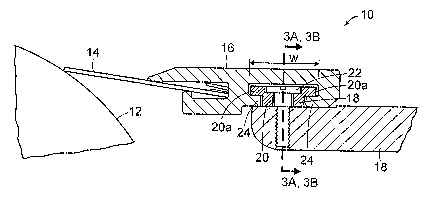Some of the information on this Web page has been provided by external sources. The Government of Canada is not responsible for the accuracy, reliability or currency of the information supplied by external sources. Users wishing to rely upon this information should consult directly with the source of the information. Content provided by external sources is not subject to official languages, privacy and accessibility requirements.
Any discrepancies in the text and image of the Claims and Abstract are due to differing posting times. Text of the Claims and Abstract are posted:
| (12) Patent Application: | (11) CA 2601965 |
|---|---|
| (54) English Title: | REMOVABLE DOCTOR BLADE HOLDER WITH LOCKABLE MOUNT |
| (54) French Title: | PORTE-RACLE AMOVIBLE AVEC MONTURE VERROUILLABLE |
| Status: | Deemed Abandoned and Beyond the Period of Reinstatement - Pending Response to Notice of Disregarded Communication |
| (51) International Patent Classification (IPC): |
|
|---|---|
| (72) Inventors : |
|
| (73) Owners : |
|
| (71) Applicants : |
|
| (74) Agent: | SMART & BIGGAR LP |
| (74) Associate agent: | |
| (45) Issued: | |
| (86) PCT Filing Date: | 2006-02-13 |
| (87) Open to Public Inspection: | 2006-08-31 |
| Examination requested: | 2007-08-20 |
| Availability of licence: | N/A |
| Dedicated to the Public: | N/A |
| (25) Language of filing: | English |
| Patent Cooperation Treaty (PCT): | Yes |
|---|---|
| (86) PCT Filing Number: | PCT/US2006/005119 |
| (87) International Publication Number: | WO 2006091427 |
| (85) National Entry: | 2007-08-20 |
| (30) Application Priority Data: | |||||||||
|---|---|---|---|---|---|---|---|---|---|
|
A doctoring apparatus for doctoring a roll surface comprises a doctor blade, a
blade holder for applying the doctor blade to the roll surface, and a doctor
back having a support surface on which the blade holder is adapted to slide. A
locking bar is subdivided into multiple mechanically interlocked segments and
is mounted by fasteners on the support surface of the doctor back for movement
lengthwise in opposite directions between locked and unlocked positions. The
locking bar is configured and dimensioned to fit loosely within a groove on
the underside of the blade holder. In its unlocked position, the locking bar
permits the blade holder to slide on the doctor back support surface into and
out of an operative position adjacent to the roll surface, hi its locked
position, the locking bar releasably secures the blade holder in its operative
position.
Appareil de raclage pour racler une surface de rouleau comportant une racle, un porte-racle pour appliquer la racle à la surface du rouleau et un arrière de racle possédant une surface du support sur laquelle le porte-racle est adapté de façon à coulisser. Une barre de verrouillage est subdivisée en de multiples segments mécaniquement solidaires et montée par des attaches sur la surface de support de l~arrière de racle pour permettre des mouvements longitudinaux dans des sens opposés entre des positions verrouillées et déverrouillées. La barre de verrouillage est configurée et dimensionnée pour s~ajuster de manière lâche dans une rainure sur le dessous du porte-racle. En position déverrouillée, la barre de verrouillage permet au porte-racle de coulisser sur la surface de support d~arrière de racle pour aller et venir d~une position opérationnelle adjacente à la surface du rouleau. En position verrouillée, la barre de verrouillage fixe de façon amovible le porte-racle à la position opérationnelle.
Note: Claims are shown in the official language in which they were submitted.
Note: Descriptions are shown in the official language in which they were submitted.

2024-08-01:As part of the Next Generation Patents (NGP) transition, the Canadian Patents Database (CPD) now contains a more detailed Event History, which replicates the Event Log of our new back-office solution.
Please note that "Inactive:" events refers to events no longer in use in our new back-office solution.
For a clearer understanding of the status of the application/patent presented on this page, the site Disclaimer , as well as the definitions for Patent , Event History , Maintenance Fee and Payment History should be consulted.
| Description | Date |
|---|---|
| Application Not Reinstated by Deadline | 2009-02-13 |
| Time Limit for Reversal Expired | 2009-02-13 |
| Deemed Abandoned - Failure to Respond to Maintenance Fee Notice | 2008-02-13 |
| Inactive: Declaration of entitlement/transfer requested - Formalities | 2007-11-13 |
| Inactive: Cover page published | 2007-11-08 |
| Inactive: Acknowledgment of national entry - RFE | 2007-11-05 |
| Letter Sent | 2007-11-05 |
| Inactive: First IPC assigned | 2007-10-23 |
| Application Received - PCT | 2007-10-22 |
| National Entry Requirements Determined Compliant | 2007-08-20 |
| Request for Examination Requirements Determined Compliant | 2007-08-20 |
| All Requirements for Examination Determined Compliant | 2007-08-20 |
| Application Published (Open to Public Inspection) | 2006-08-31 |
| Abandonment Date | Reason | Reinstatement Date |
|---|---|---|
| 2008-02-13 |
| Fee Type | Anniversary Year | Due Date | Paid Date |
|---|---|---|---|
| Basic national fee - standard | 2007-08-20 | ||
| Request for examination - standard | 2007-08-20 |
Note: Records showing the ownership history in alphabetical order.
| Current Owners on Record |
|---|
| KADANT WEB SYSTEMS, INC. |
| Past Owners on Record |
|---|
| JOHN ROTHERHAM |